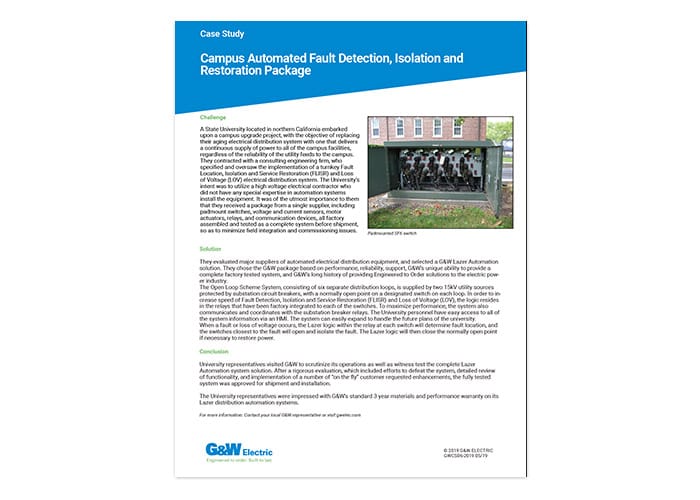CHALLENGE:
A State University located in northern California embarked upon a campus upgrade project, with the objective of replacing their aging electrical distribution system with one that delivers a continuous supply of power to all of the campus facilities, regardless of the reliability of the utility feeds to the campus. They contracted with a consulting engineering firm, who specified and oversaw the implementation of a turnkey Fault Location, Isolation and Service Restoration (FLISR) and Loss of Voltage (LOV) electrical distribution system. The University’s intent was to utilize a high voltage electrical contractor who did not have any special expertise in automation systems install the equipment. It was of the utmost importance to them that they received a package from a single supplier, including padmount switches, voltage and current sensors, motor actuators, relays, and communication devices, all factory assembled and tested as a complete system before shipment, so as to minimize field integration and commissioning issues.
SOLUTION:
They evaluated major suppliers of automated electrical distribution equipment, and selected a G&W Electric Lazer® Automation solution. They chose the G&W Electric package based on performance, reliability, support, G&W Electric’s unique ability to provide a complete factory tested system, and G&W Electric’s long history of providing Engineered to Order solutions to the electric power industry.
The Open Loop Scheme System, consisting of six separate distribution loops, is supplied by two 15kV utility sources protected by substation circuit breakers, with a normally open point on a designated switch on each loop. In order to increase speed of Fault Detection, Isolation and Service Restoration (FLISR) and Loss of Voltage (LOV), the logic resides in the relays that have been factory integrated to each of the switches. To maximize performance, the system also communicates and coordinates with the substation breaker relays. The university personnel have easy access to all of the system information via an HMI. The system can easily expand to handle the future plans of the university. When a fault or loss of voltage occurs, the Lazer logic within the relay at each switch will determine fault location, and
the switches closest to the fault will open and isolate the fault. The Lazer logic will then close the normally open point if necessary to restore power.
CONCLUSION:
University representatives visited G&W Electric to scrutinize its operations as well as witness the factory acceptance test of the complete Lazer Automation system solution. After a rigorous evaluation, which included efforts to defeat the system, detailed review of functionality, and implementation of a number of “on the fly” customer requested enhancements, the fully tested system was approved for shipment and installation.
The university representatives were impressed with G&W Electric’s standard 3-year materials and performance warranty on its Lazer distribution automation systems.

